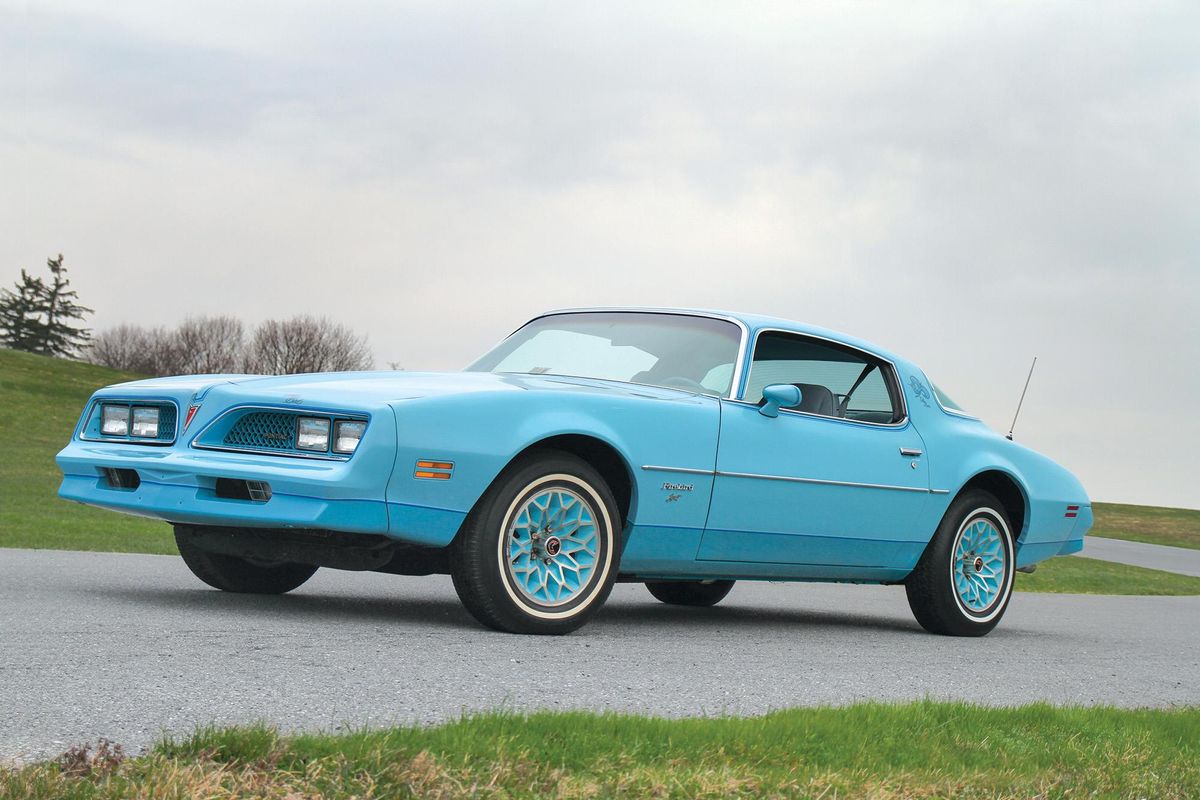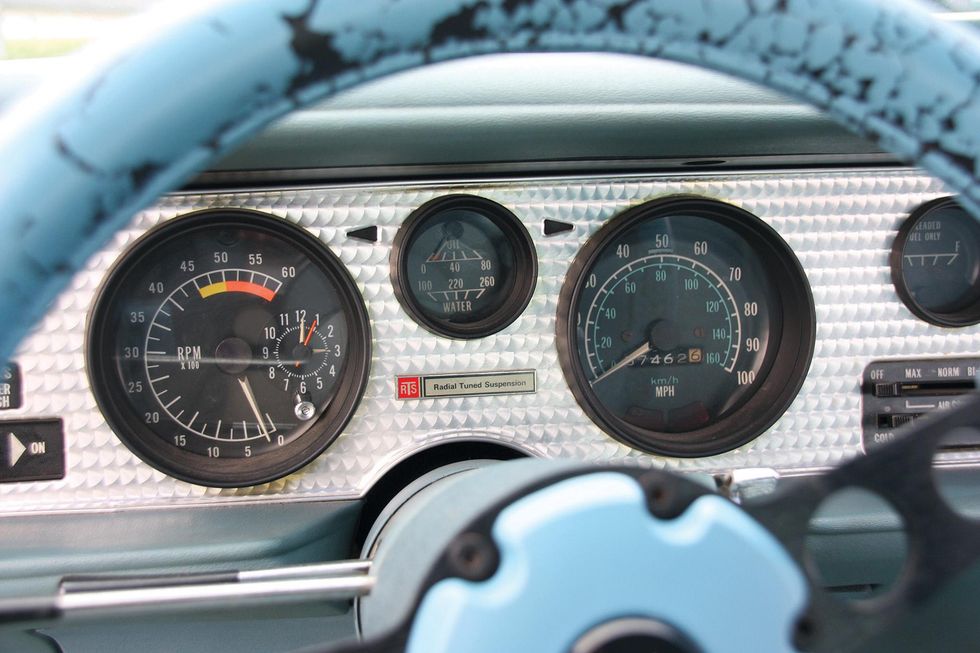For those fans of American performance cars, the world came to an end (at least temporarily) after the 1974 model year. The GTO, once the king of muscle cars, had been relegated to a 350 V-8 on a chassis shared with Pontiac’s compact Ventura, and it was conspicuously absent from the model lineup the following year. Furthermore, the special Super Duty 455 V-8, available in Firebirds, was never to return.
Beginning in 1975, catalytic converters were the new norm and necessitated the use of unleaded fuel; five-mph bumpers were now de rigueur; and computer-controlled engines were in their infancy. The last vestiges of performance were struggling to survive. For Pontiac, whose sales success of the late Fifties to the early Seventies relied on performance, things looked bleak.
Sure, you could still order a big 455 in your new Grand Ville, Bonneville, Catalina, Grand Prix, Le Mans, or Grand Am, but it was a detuned version of what once ruled the streets. Firebird, Pontiac’s sporty pony car, shared its engine lineup with other Pontiacs, so it too was subject to the downgraded performance of its siblings. Ironically, in this era of weakened performance, the Firebird had its best sales years, thanks to the meteoric rise in Trans Am sales.
When did Pontiac introduce the Sky Bird?
The second-generation F-body Firebird and Camaro were introduced in 1970. Pontiac offered four flavors—base, Esprit, Formula, and Trans Am. While the Formula and Trans Am were geared to those looking for all-out performance, the base model appealed to folks on a budget, and the Esprit to a buyer who wanted a little luxury with their sportiness. Esprits typically included such standard upgrades as body-colored sport mirrors with lefthand remote, color-keyed seat belts, center console, bright exterior moldings, and concealed windshield wipers.
As the Seventies progressed, Pontiac recognized that 30 percent of Firebird buyers were women. Not everyone wanted the macho image of the Trans Am and GM marketers smartly realized it was necessary to offer alternatives to the bad boy image of Pontiac’s performance flagship. The Esprit was the perfect choice and Pontiac, looking to expand market share, used the Firebird as the basis for three special editions.
The first of three special Esprits debuted at the Chicago Auto Show in February 1976 as a show car. Called Blue Bird, it was for all intents and purposes a “tape and paint job” that became known officially as the “Esprit Luxury Appearance Package.” The car proved a hit with consumers and Pontiac announced in May 1976 that a production version was to be introduced for the 1977 model year. There was only one problem: Reportedly, the Blue Bird Body Company of Georgia, a builder of school busses, had trademarked the name for automotive use and objected to the use of Blue Bird on another company’s vehicle. Pontiac thus changed the name to Sky Bird.
Pontiac’s 1978 Firebird Sky Bird was offered with the divisions array of engine options; however, this one was delivered to its original owner with a 170-hp version of the 350-cu.in. V-8.
What did the Sky Bird package include?
With the naming issue resolved, the package—RPOW60 — moved to production, consisting of unique body-colored cast aluminum wheels, two-tone paint, accent stripes, blue-painted grille, blue-painted taillamp bezels, Sky Bird decal identification, a Formula steering wheel, custom seat belts, and the choice of a blue vinyl or velour cloth interior. The exterior received Code 21 Lombard Blue, a color borrowed from Pontiac’s Astre (a twin to the Chevy Vega), while the lower accent color was not shared with other Pontiacs. The full array of Firebird options was available for Sky Birds, enabling buyers to custom-build the vehicle of their choice.
In addition to the body-colored “snowflake” wheels not shared with any other Pontiac, the 1977 Sky Bird had another unique feature. Formula steering wheels came in one color, regardless of the Pontiac model: black. Sky Birds, however, featured a specific blue Formula-style steering wheel not offered in other Pontiacs.
The Sky Bird package was renewed for the 1978 model year. Adding $461 to the Esprit’s bottom line, its Lombard Blue paint code was changed to 30. Pontiac chose to promote the special model in a print ad featuring the Special Edition Solar Gold Trans Am, a Mayan Red Formula, and the Sky Bird. It cleverly stated, “There’s a Firebird for every purpose. Except standing still.”
The Sky Bird’s interior was finished in blue vinyl or cloth upholstery, in addition to a special blue Formula-style steering wheel, the color of which tended to deteriorate —even when restored.
When did Pontiac add the Red Birds and Yellow Birds?
In addition to the continuation of the Sky Bird package, 1978 welcomed a companion Red Bird model. Like its special sibling, it debuted at the Chicago Auto Show, this time in February 1977. The special Red Bird package was identified by RPOW68 and featured a Roman Red (Code 72) exterior for the upper color and a unique color for the bottom band called Red Bird Red (Code 42). Red Bird’s interior was Carmine Red with gold accents similar to those used on Special Edition Trans Ams for ’78. While the Sky Bird was discontinued for the 1979 model year, the Red Bird remained available for an additional year; the ’79 models used Mayan Red (Code 75) for the upper color. The bottom color remained the same, but the code was changed to 80. Firebird sales set a record for 1979 —not bad for a car whose basic design was now ten years old.
As an added twist, the new-for-1980 Yellow Bird became the third and final special-edition Esprit appearance package; its yellow color was not shared with other Pontiacs. The upper color was Code 56 with the lower accent color Code 37. Oddly, the unique hues weren’t given names in Pontiac brochures and marketing materials. Unlike the Sky Bird and Red Bird, the interior of the Yellow Bird was a contrasting color—Camel Tan—with gold accents like those used in the aforementioned Special Edition Trans Ams. The Yellow Bird was a one-year-only special, ending the trilogy of unique Esprits. Production records don’t exist as to how many were built, though online sources indicate about 4,000 units over four years. Considering overall Firebird production, that’s not a lot of cars and survivors are few.
Our featured Sky Bird
The original owner of our featured Sky Bird was Patricia Lovass, a military nurse who took delivery of her new 1978 edition while living in Colorado. Her special Esprit came equipped with lots of options, including a 170-hp version of Chevrolet’s 350-cu.in. V-8, automatic transmission, air conditioning, remote decklid release, sport gauges, and heavy-duty alternator, among others. Patricia regularly used the car; in fact, she drove it what some would consider to be a considerable 157,000 miles in three decades—including a move to Virginia— before donating it to the AACA Museum, Inc., in Hershey, Pennsylvania, on December 7, 2009.
Despite well-intentioned regular maintenance and care, the Sky Bird showed the kind of wear and tear most 30-year-old vehicles typically accumulate, especially rust that had begun to appear on the rear quarter panels, a not-uncommon malady that affects F-bodies of this era.
AACA Museum Executive Director Jeff Bliemeister, who was the Museum’s curator at the time, remembers going to pick up the car in Virginia on a snowy winter day. “The roads became treacherous, and it was a tough go, but I made it home safely with the Firebird in tow,” he says. While Jeff was returning to the museum, he was struck by a thought. The Museum has (to this day) an ongoing relationship with Penn College of Technology (PTC) in Williamsport, Pennsylvania, and their automotive restoration program. Previously, the school, along with the Susquehannock Region of the AACA, spearheaded the restoration of two museum vehicles: a 1970 Chevrolet Chevelle SS 454 LS6 and a 1965 Ford Mustang convertible. Why not the Firebird?
Restoring the Sky Bird
Roy Klinger, head of the restoration program at the college, was contacted, arrangements were made, and the Firebird was subsequently delivered to the school. The students worked on the Sky Bird for 32 weeks (equating to two semesters) repairing the rust, painting the car, and installing the interior and new parts that had been generously donated by National Parts Depot. The Hershey Region of the AACA provided an additional $5,000 donation to support the project.
“It was a really straight car,” Roy says, “and the rust was confined mostly to the lower rocker panels. We were unable to get an interior to match the original vinyl, so a velour cloth interior was installed, but otherwise, the car is restored to its as-built condition. The Susquehannock Region members were able to source original decals, but not all the striping, so the students painted them to match the originals.”
After the restoration was completed, a ceremony was held at the Museum in conjunction with its annual car show on June 25, 2011. Jeff, members of the staff and faculty at PCT, students who worked on the car, members of the Susquehan-nock and Hershey Regions of the AACA, and most importantly, the Sky Bird’s original owner, Patricia, were all in attendance to take part in the dedication. Thanks to many generous people, the Sky Bird had officially returned to the nest to became part of the Museum’s permanent collection. Check out the AACA Museum, online at aacamuseum.org.
 Photo by David Conwill and Matthew Litwin
Photo by David Conwill and Matthew Litwin



















 Photo by David Conwill and Matthew Litwin
Photo by David Conwill and Matthew Litwin




